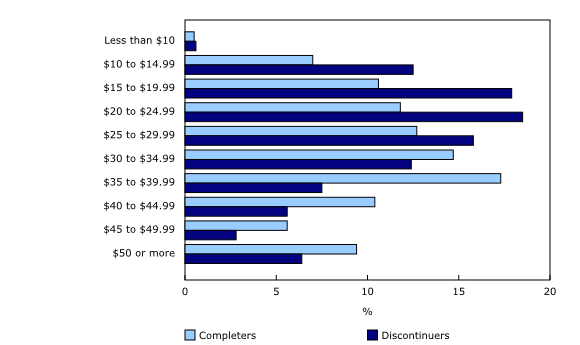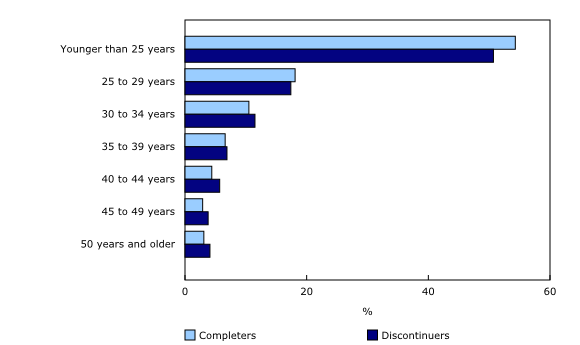Completing an apprenticeship in Canada yields benefits, 2015
Archived Content
Information identified as archived is provided for reference, research or recordkeeping purposes. It is not subject to the Government of Canada Web Standards and has not been altered or updated since it was archived. Please "contact us" to request a format other than those available.
Released: 2017-03-29
Skilled tradespeople are vital to supporting industries that drive Canada's economy. Strong economic growth in areas such as construction and natural resources, combined with an aging workforce, have contributed to increased demand for skilled tradespeople in Canada.
Apprenticeship training is one of the most common ways to help prepare individuals for a career in the trades. The new 2015 National Apprenticeship Survey (NAS) looked at who was registering for apprenticeships and whether apprentices were using available financial support programs. The survey also looked into why some apprentices did not complete their apprenticeship programs.
Results from the 2015 NAS show that, overall, there were clear benefits for apprentices in completing their programs. Those who completed an apprenticeship program were more likely to have a permanent job, employment benefits and income, than those who left their programs before completion. For example, 81% of those who completed their apprenticeships had a permanent job, compared with 77% who had not completed their programs.
Looking at who was most likely to register for an apprenticeship, the results show that it was those with potential to move where the jobs are—primarily young, single men aged 15 to 24 years. Nevertheless, after completing their programs, the vast majority (95%) stayed in the province where they apprenticed.
Apprentices who complete their programs are more likely to find employment
The majority of apprentices went on to secure employment, that is a permanent job with benefits. Nevertheless, success in securing employment was higher for those who completed their apprenticeship programs than for those who did not. Another benefit of completing an apprenticeship program was a higher average annual income compared with those who did not complete their apprenticeships. Those who completed their programs had an average annual income of $69,512 or an hourly wage of $33/hour. By comparison, those who did not complete their apprenticeships made $59,782 on average annually or $28/hour.
More than 8 out of 10 apprentices were employed in 2015. Immigrant apprentices had a similar employment rate to apprentices overall at 80%, while Aboriginal apprentices (76%) and women (73%) had somewhat lower employment rates.
Among the top 10 Red Seal trades, the majority of those who completed their programs (89%) held a job related to the trade of their apprenticeships. Results ranged from 80% for hairstylists to 96% for plumbers. The Interprovincial Red Seal Program is the Canadian standard for skilled trades and allows tradespeople to have their skills recognized across the country. The majority of apprentices (78%) were enrolled in the program.
Provinces and territories invest in apprenticeships to develop tradespeople that contribute to their economies. NAS results showed that following their apprenticeship programs, the majority of apprentices, whether they completed their program (94%) or not (90%), were employed in the same province or territory where they had trained.
Most apprentices are young, male and Canadian-born
Apprentices continued to be mainly young men who were born in Canada. There was a notable underrepresentation of women and immigrants in these programs.
Women form about half of the population in Canada, but they accounted for 14% of apprentices. Similarly, immigrants accounted for 9% of apprentices, less than half their share (23%) of the population of Canada aged 15 and over.
Things were somewhat different for apprentices who were Aboriginal. Aboriginal apprentices accounted for 6% of all apprentices in 2015, a slightly higher representation than their share of the Canadian population (4% of those 15 years and over). Looking specifically at Métis apprentices, they made up 3% of all apprentices in Canada, more than double their representation among Canadians 15 and over (1.3%).
Apprentices can be certified in trades that are not designated Red Seal, however, a large share of apprentices were in the Red Seal trades. For example, over half of all apprentices were in the top 10 Red Seal trades. In fact, 13% of all apprentices were in the Red Seal trade of carpenter, and another 12% were in the construction electrician trade.
Job instability and finances are difficulties for those who do not complete their apprenticeships
There can be many reasons why apprentices may not complete their programs. Even those who complete their programs face challenges along the way. Nevertheless, looking at both those who completed their programs and those who did not, nearly two-thirds reported experiencing no difficulty progressing through their programs. As one might expect, however, those who did not complete their programs were more likely (44%) to have experienced difficulty than those who completed their programs (27%).
When asked what was the main reason for not completing their apprenticeship programs, job instability was the most commonly cited barrier (17%), followed by the fact that they had received a better job offer (16%). As a main reason for not completing their programs, financial constraints were the third most common reason (11%).
Apprentices' training is largely funded through the on-the-job portion of an apprenticeship, where employers are the primary source of income. Nevertheless, many apprentices tapped into available grants, tax credits and Employment Insurance benefits to help pay for their training expenses. For example, more than one-third of apprentices claimed a tax credit for expenses such as tuition or tools.
Almost all apprentices view trades as a good career path
The vast majority of apprentices (more than 90%) reported that trades are a good career option, and that an apprenticeship program is the best way to learn a trade. Moreover, the majority of apprentices also believed that trade occupations pay better than other jobs. However, the percentage of apprentices who felt this way varied by trade. For instance, 90% of steamfitter / pipefitter apprentices reported that trade occupations pay better than other jobs, compared with 61% of cook apprentices. Moreover, men were more likely than women to report that trades pay better than other jobs.
Note to readers
Context
The National Apprenticeship Survey (NAS) 2015 looks at various factors affecting the completion, certification and transition of apprentices to the labour market. It builds on the content and experience gained through previous surveys on apprentices, the last one completed in 2007. The 2015 survey was a collaborative effort between Employment and Social Development Canada and Statistics Canada.
A sample of over 28,000 respondents—who had either completed or discontinued an apprenticeship program from 2011 to 2013—was contacted.
The Canada Overview report presents a profile of apprentices and their experiences in apprenticeship programs in Canada, including technical training and on-the-job training; challenges and difficulties faced; awareness and use of financial support programs; the certification process, including Red Seal; labour market outcomes and job satisfaction; interprovincial mobility; and attitudes about skilled trades.
Definitions
Aboriginal identity refers to whether the person reported identifying with the Aboriginal peoples of Canada. This includes those who reported being an Aboriginal person, that is, First Nations (North American Indian), Métis or Inuk (Inuit) and/or those who reported Registered or Treaty Indian status that is registered under the Indian Act of Canada and/or those who reported membership in a First Nation or Indian band. Aboriginal peoples of Canada are defined in the Constitution Act, 1982, Section 35 (2) as including the Indian, Inuit and Métis peoples of Canada.
An apprenticeship program is a structured system of supervised training leading to certification in a trade/occupation which is governed by regulations under a Provincial or Territorial Apprenticeship Act. It consists of systematic programs of on-the-job training (required hours of work), supplemented by in-school technical instruction (required course work) in which an apprentice gains the knowledge, skills, tools and materials of the trade, occupation or craft. During a typical apprenticeship, an apprentice's time is divided between the workplace (80% to 90%) and the classroom (10% to 20%).
The term immigrant refers to a person who is or has ever been a landed immigrant/permanent resident. This person has been granted the right to live in Canada permanently by immigration authorities. Some immigrants have resided in Canada for a number of years, while others have arrived recently. Some immigrants are Canadian citizens, while others are not. Most immigrants are born outside Canada, but a small number are born in Canada. In the 2011 National Household Survey, 'Immigrants' includes immigrants who landed in Canada prior to May 10, 2011.
The Red Seal Program is an industry-driven program delivered in partnership with the provinces and territories, which are responsible for apprenticeship training and certification. Since the early 1950s, the Red Seal Program has developed common standards and examinations for the Red Seal trades in close collaboration with industry. Trades approved for Red Seal status are called "designated Red Seal trades." The Red Seal Program and the designation of trades as Red Seal is the responsibility of the Canadian Council of Directors of Apprenticeship. Tradespersons who meet the Red Seal standards receive a Red Seal endorsement on their provincial/territorial trade certificates.
Products
The publication National Apprenticeship Survey: Canada Overview Report 2015 (81-598-X) is now available.
Contact information
For more information, or to enquire about the concepts, methods or data quality of this release, contact us (toll-free 1-800-263-1136; 514-283-8300; STATCAN.infostats-infostats.STATCAN@canada.ca) or Media Relations (613-951-4636; STATCAN.mediahotline-ligneinfomedias.STATCAN@canada.ca).
- Date modified:



